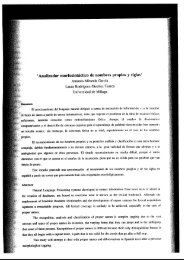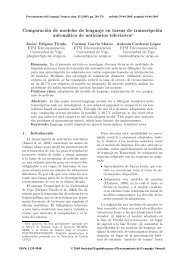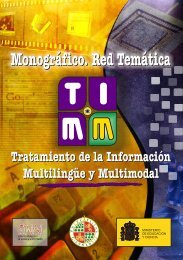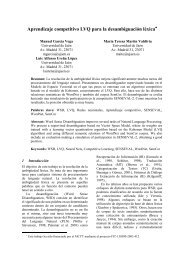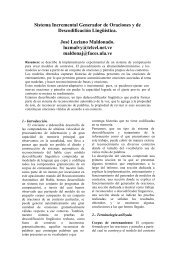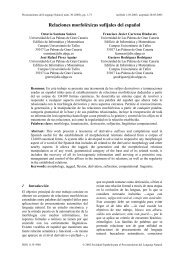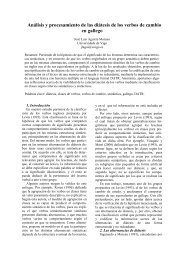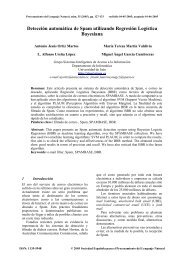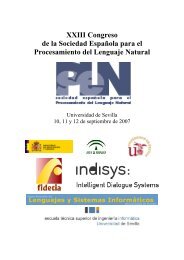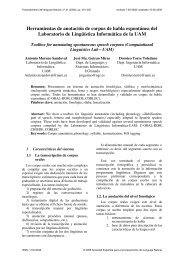A Machine Learning Approach for Factoid Question Answering - sepln
A Machine Learning Approach for Factoid Question Answering - sepln
A Machine Learning Approach for Factoid Question Answering - sepln
Create successful ePaper yourself
Turn your PDF publications into a flip-book with our unique Google optimized e-Paper software.
Comelles, 2005), this NERC obtains the results<br />
reported in Table 2.3 (on the CONLL<br />
test corpus).<br />
For the actual AE task we trained a single<br />
classifier which decides if a candidate answer<br />
is an appropriate answer or not. In Section<br />
3 we show the experimental results when<br />
we train the AE classifier using three different<br />
ML frameworks: Maximum Entropy, AdaBoost<br />
and SVM. All of them give as output<br />
a raw activation in the interval [-1..+1],<br />
which helps us to sort the candidates not just<br />
by a binary choice but by plausibility.<br />
The features used by our AE classifier are<br />
grouped in two sets, described below:<br />
Features that measure keyword<br />
frequency and density (F1)<br />
(H1) Same word sequence - computes the<br />
number of words that are recognized in<br />
the same order in the answer context;<br />
(H2) Punctuation flag - 1 when the candidate<br />
answer is followed by a punctuation<br />
sign, 0 otherwise;<br />
(H3) Comma words - computes the number<br />
of question keywords that follow the<br />
candidate answer, when the later is succeeded<br />
by comma. A span of 3 words<br />
is inspected. The last two heuristics are<br />
a basic detection mechanism <strong>for</strong> appositive<br />
constructs, a common <strong>for</strong>m to answer<br />
a question;<br />
(H4) Same sentence - the number of question<br />
words in the same sentence as the<br />
candidate answer.<br />
(H5) Matched keywords - the number of<br />
question words found in the answer context.<br />
(H6) Answer span - the largest distance (in<br />
words) between two question keywords<br />
in the given context. The last three<br />
heuristics quantify the proximity and<br />
density of the question words in the answer<br />
context, which are two intuitive<br />
measures of answer quality.<br />
The F1 feature set is inspired by the<br />
heuristics proposed by (Pa¸sca, 2003). However,<br />
in (Pa¸sca, 2003) the values of these<br />
heuristics are combined in a non linear <strong>for</strong>mula<br />
generated by a human expert 1 . This<br />
1 Further references in this paper to heuristics refer<br />
to the approach showed by (Pa¸sca, 2003).<br />
David Dominguez-Sal and Mihai Surdeanu<br />
134<br />
hand-made <strong>for</strong>mula gives state-of-the-art results<br />
<strong>for</strong> a factoid QA. But, the addition of<br />
new features is very difficult: <strong>for</strong> every new<br />
heuristic we want to add, the <strong>for</strong>mula has to<br />
be readjusted by an expert. Moreover, as the<br />
number of heuristics to consider increases,<br />
the tuning of the <strong>for</strong>mula becomes more complex.<br />
On the other hand, our machine learning<br />
approach avoids the intervention of an<br />
expert. The addition of new features does<br />
not require the intervention of a human expert<br />
but a new training of the model. It also<br />
reduces adaptation costs of a AE module to<br />
different collection types.<br />
All the features are normalized in range<br />
[0..1] and then discretized by intervals: [1..1],<br />
(1..0,95], (0,95..0,85], etc. For those heuristics<br />
whose value depends on the number of<br />
keywords (as same sentence), we normalized<br />
the value dividing it by the number of keywords.<br />
For example, if we have two keywords:<br />
president and Spain, and a passage<br />
...the King of Spain met french Prime Minister...,<br />
where only Spain is found: same sentence<br />
would be evaluated as 1<br />
2 =0.50.<br />
Features that verify the occurrence of<br />
certain patterns (F2) (the Entity<br />
underlined corresponds to the candidate<br />
answer we are evaluating and Description to<br />
a part of a sentence):<br />
(P1) Entity ,|( Description ,|)|. For example:<br />
“Paris, the capital of France,...”.<br />
(P2) Entity ( Entity of type location ) For<br />
example: “...inaugurated a new research<br />
center in Cluj (Romania)”.<br />
(P3) Entity verbToBe Description For example:<br />
“Caesar was the first living man<br />
to appear on a Roman Republican coin”.<br />
(P4) Entity questionVerb Description :<br />
Where questionVerb is the same verb as<br />
in question. For example, “Cervantes<br />
wrote Don Quixote in 1605”, <strong>for</strong> the<br />
question “Who wrote ’Don Quixote’?”.<br />
Additionally, four more patterns are implemented<br />
with Description and Entity positions<br />
reversed.<br />
Each pattern-based feature measures the<br />
matching of a Description (part of a sentence)<br />
against the question. Matching is calculated<br />
as the average of the number of words



